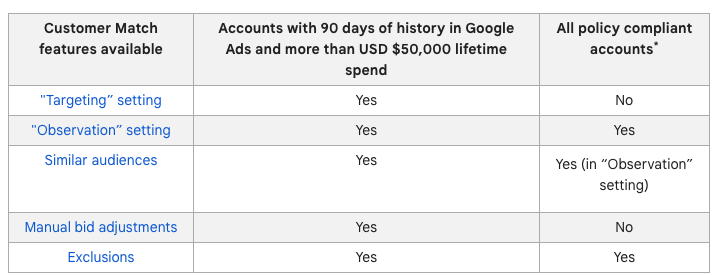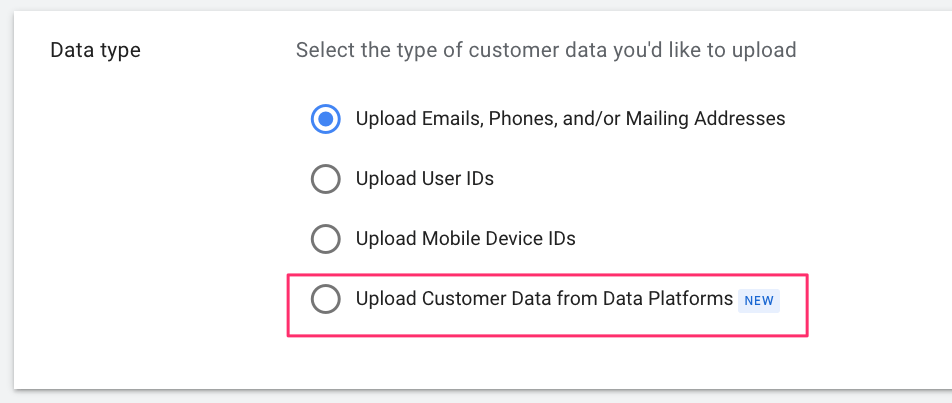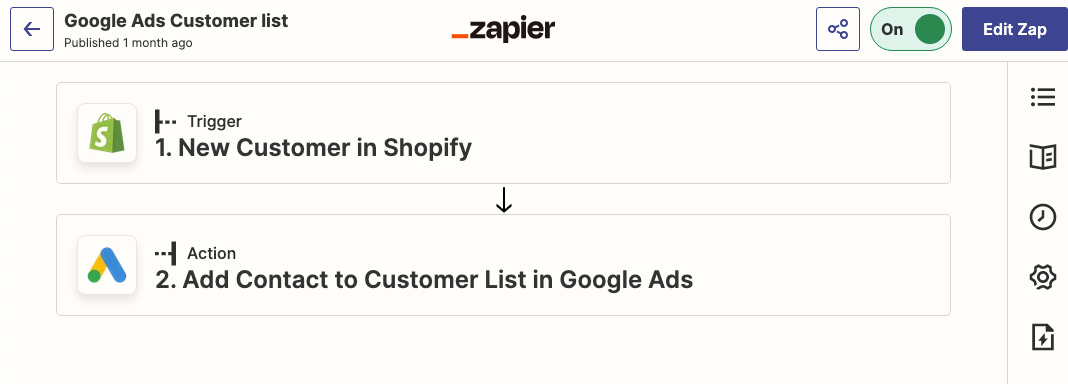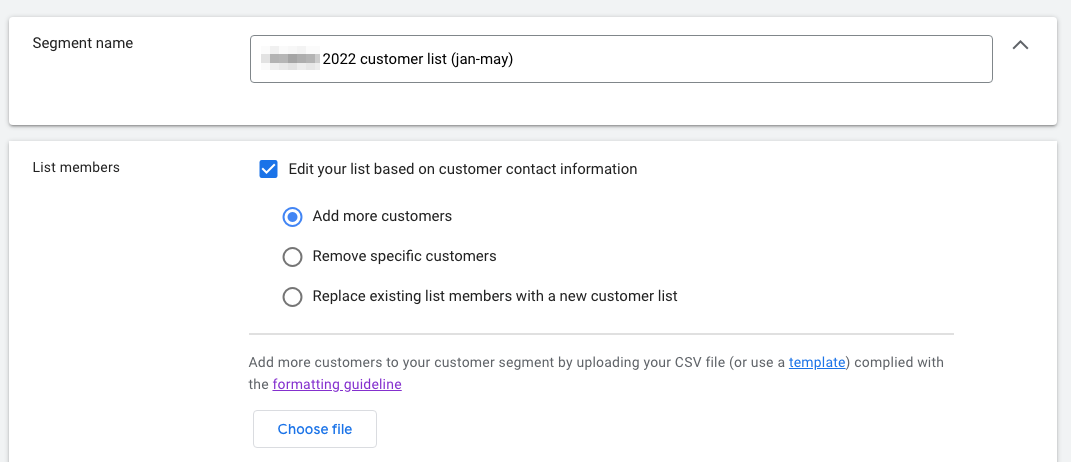Google’s Customer Match allows advertisers to leverage customer data to reconnect to previous customers and find new ones across the Google Ads network.
This feature helps you leverage the customer information that you’ve collected from buyers or prospects to target with a variety of ads.
In this article, we’ll dive deeper into what Customer Match is, and share 7 strategies of how you can leverage it in your campaigns.
Table of Contents
What is Customer Match for Google Ads?
Google Customer Match allows you to upload a list of customer or prospect contact information (email or phone numbers), which Google Ads then uses to match to their profiles.
Customer Match is an audience targeting option that uses your data to re-engage with your current customers, as well as reach out to new users that are similar to them.
This feature is capable of targeting users across Google’s Search Network, like Search Ads and Shopping Ads, and on the Display Network, like Gmail, YouTube, and other third-party sites.
How Does Customer Match Work
Customer Match works as follows:
- You pick one of the matching options: Email address, Phone, Mailing address, or Combined Matching.
- You upload customer or prospect contact information depending on the matching options you’ve picked
- Google looks through its database to find these users
- It creates a new audience with all the matched profiles
- You can use this new audience with your campaigns
- Google also creates a Similar Audience, more on that further in the article
Benefits of using Google Customer Match
There are three benefits to using Customer Match.
Increase in conversion rate
Customer Match allows you to target people that have already purchased from you or people that Google considers very similar.
For both audiences, it means a huge step up compared to cold audiences, which results in a much better conversion rate.
More accurate targeting
If you followed local privacy regulations, your customer should have given you their data themselves.
This means Customer Match uses first-party data.
This not only results in the data being more accurate, but it also helps you to steer clear of issues caused by the iOS14 update.
Cross-device targeting
With remarketing, you’re targeting people based on cookies. These are small files that are saved to the user’s device, which allows you to identify them.
This can be useful, but there are all sorts of downsides to this method as well.
If you open a website with Chrome on your phone and then open it with Safari on your computer, cookies would count this as two separate sessions.
Cross-device targeting however would remember the user across other devices and web browsers, making it much more consistent.
This of course is limited to the people you can identify with an email address or phone number.
What are the requirements for Customer Match?
There are two essential requirements to be able to use Customer Match:
- A good track record of policy compliance
- A good payment record
This is the case for most advertisers.
But to use the “full feature set” of Customer match, there are 2 additional requirements:
- At least 90 days of Google Ads history
- More than $50,000 (USD) total lifetime spend on your account
The main difference between the “full”, and “light” feature sets of Customer match is that in the latter, you’re not able to exclusively target the Customer Match audience. You can only do so in Observation mode, as part of another audience targeting.
If you’ve got the light version, you’ll see warnings like this:
Here is an overview:

I want to stress again that whenever you upload, it needs to be your data. All people on the list need to have given you permission to include their information, following local laws like GDPR or CPRA.
Customers’ emails or people signed up to your email newsletter are ok to use with Customer Match.
Lists that you’ve bought are not. Google is pretty strict on this. And if they catch you, you run the risk of Customer Match being disabled, or your whole account getting suspended!
7 Strategies to Leverage Customer Match
In this section, we’ll look at when to use Customer Match.
We’ll start with simple things that are accessible to most advertisers, and continue to things that only big advertisers with huge email lists can do.
1 – Audience exclusions
The first use case of Customer Match is a pretty straightforward one.
If you’re running a campaign that needs to reach new customers, you can use your customer match audience to exclude these people from being targeted.
I wouldn’t use these in Search or Shopping campaigns, but with Display or YouTube, you might want to take more control over your funnel.
2 – Fuel for Smart Bidding
Smart Bidding is a collection of campaign types or campaigns that use certain bid strategies. They all have in common that you can’t select audiences, or make specific bid adjustments for them.
That doesn’t mean audiences, and customer match audiences aren’t relevant though!
For Google Performance Max campaign, all of the audiences inside of your Audience Manager are used.
So if you have high-quality customer lists uploaded, you’re giving Google a lot of extra signals to hone their bids with.
Note: this is a fairly recent update, and isn’t rolled out to all Smart Bidding campaigns yet.
3 – Sell more to your existing customers
One of the easiest ways to grow your business is to sell to existing customers. Customer Match allows you to target these customers across Google placements.
Let’s say you run a jewelry store and have your customer list uploaded to Google.
Then, as part of the Audiences in your Standard Shopping campaign, you’ve got the “All customers” audience segment added with a bid adjustment of +50%.
Then when someone who’s on that list searches for “rose gold necklace”, which triggers one of your products, you’ll bid 50% in the ad auction.
This higher cost per click allows you to have more visibility compared to competitors. And because the person searching has more familiarity with your brand, the chance of getting the click (and sale) is a lot higher,
One of the requirements to use these audiences on Shopping and Search campaigns is that you have at least 1,000 people in that audience. So you’ll need to have at least a few thousand customers on your list to end up with 1,000 matched profiles.
4 – Convert prospects into customers
Although this feature is called “Customer” Match, you can also use it to upload the email address of people on your list that hasn’t purchased.
You can use them as part of your regular targeting in Search or Shopping, or design specific Display or YouTube campaigns to convert them.
Because they already have some familiarity with your brand, you will see higher response rates compared to cold audiences.
5 – Re-engage seasonal customers
You can also use Customer Match to heighten awareness of your seasonal promotions.
In our example of the jewelry business, the Customer Match feature can help you target those who purchased bracelets or necklaces as Christmas gifts last year. Showing ads might entice them to consider your site for this year’s purchases.
6 – Cross-selling
Another variation of selling to existing customers is to promote different categories.
If you’ve sold a pair of earrings to a customer, they might be interested in a matching pair of bracelets.
Please note that cross-selling is often done through email marketing. So using Display or YouTube Ads might not be optimal, but it can be one of the options in your toolbox.
7 – Reaching Similar audiences
When you upload a new customer list, Google Ads will automatically create a Similar Audience:
In the screenshot above, I uploaded the “2022 customer list” audience, then Google created “Similar to 2022 customer list”
Because Google knows the characteristics of the people who are part of your original audience, it will use this information to populate the new audience.
If you’re familiar with Facebook Ads, it might sound a lot like the lookalike audiences. They are very similar.
These Similar Audiences usually are a lot bigger as well. You can see my original customer list has 2,300 matched profiles. While the similar audience has 50K-100K profiles!
This can be great to expand your reach in all sorts of campaigns.
Bonus strategy: Segment your list
If you have a big email list, you can also try segmenting your audience. You could for example include your 10% most valuable customers.
Then Google uses the characteristics of those customers, to create a Similar Audiences that looks similar to your high-value customers.
This doesn’t always pay off, but it’s well worth experimenting with!
What is A Good Customer Match Rate?
Google won’t be able to find every customer email you upload amongst its profiles.
When you upload a list, Google will give you a match rate, which indicates what percentage of customers it was able to match to a profile.
Most advertisers’ match rates are between 29% and 62%. But if you have a high-quality list, you can get match rates between 70% and 90%.
In the screenshot above you can see this advertiser managed to get a 90% match rate, which is very good!
| Match rate | Score |
| 0-28% | Low |
| 29-62% | Medium |
| 63-10% | High |
Not that the match rate percentage is not an indicator of how well your Customer Match audience will perform.
But it does indicate how accurate your customer data is. If you always get low match rates, maybe you should look into how you can improve your data quality.
How to Improve Customer Match Rate
To have a higher Customer Match rate, provide more data.
According to Google, advertisers who upload two match keys increase their match rate by 28 percent on average.
This is further improved to 35 percent if you have three match keys.
Available match keys:
- Phone number
- Address
How to get started with Customer Match in Google Ads
Before using Customer Match, you’ll need to prepare a few things. Start by creating the necessary data file or your customer list.
Create your Customer List
The first thing you need to do if you want to utilize the Customer Match feature is to create your customer list. It’s a file that contains the contact information of your customers.
Create a spreadsheet that contains the following headers:
- Phone
- First Name
- Last Name
- Country
- Zip
After that, fill in the rest of the cells with the information of your customers.
As mentioned before, what information you supply depends on the matching option you select:
- Email address matching
- Phone matching
- Mailing address matching
- Combined matching
Note that combined matching will give you the best chances at a high match rate.
Refer to Google’s formatting guidelines for creating a customer data file to guide you with the proper format. Make sure to save your data as a CSV file type as this is the format required by Google.
Alternatively, you can also download the customer list template and follow the instructions contained within to create your customer list.
Upload your Customer List to Google Ads
Once you’re done with the customer list, you can now upload it to Google Ads. Here are the steps on how to do it:
- First, sign in to your Google Ads account.
- Next, click the Tools and Settings icon found at the top of your screen.
- Then, choose Audience manager under Shared Library.
- At this point, you’ll need to create a new audience list. To do so, click the blue plus button and choose Customer list.
- Add a name and select “Upload Emails, Phones, and/or Mailing Addresses” as the data type.
- Choose whether you want to upload a plain text file or a hashed data file. A hashed data file helps protect your data from interceptors.
- This time, select the customer list file that you wish to upload.
- Check the box that says, “This data was collected and is being shared with Google in compliance with Google’s policies.”
- Afterward, set a membership duration. By default, the duration is set to unlimited but you can change it to your preference.
- Finally, click Upload to submit your file. This process may take up to 48 hours depending on the volume of your data.
Once your customers’ data have been uploaded, you’ll be notified of the status regarding the total number of rows and your match rate percentage.
Upload your Customer List From Data Platforms
Until recently, the only way to upload customer data to Google Ads was to manually upload files.
But that has changed with Data Platforms.
Google Ads now integrates with a ton of other platforms through Zapier like Shopify, Klaviyo, Bigcommerce, Marketo, Pipedrive, Campaign Monitor, etc.
I synced my Shopify store through Zapier with Google Ads. Now every time someone makes a purchase, they’re automatically added to my customer list in Google Ads
Note: Zapier costs something like $29/mo.
Keeping Customer Match Lists Up To Date
If you’re manually uploading customer lists to Google Ads, like most advertisers, you’ll need to keep your list up to date.
That means performing regular uploads to update existing information:
It’s quite a hassle to export, prep, and import customer data, so I will usually do it only a few times a year. Usually ahead of big sales periods like Black Friday.
But as we covered in the previous section, Google is now experimenting with ways to automatically keep your lists in sync. So in the future, I’ll be recommending bigger advertisers move to use this auto sync option.
If you’re a smaller advertiser and don’t have a Zapier account, I’d stick with the manual option to avoid paying the extra fee.
Customer Match Opt-Out
Since your customers can give you permission to use their email addresses for other purposes, it’s given that they also have the right to revoke it at any time. If that happens, you will need to remove their email addresses from your current customer list. You can do this by uploading a new CSV file to edit your list.
This option can be accessed in the edit window of your customer list, which can be found in the Audiences section
Reconnect And Find New Customers
The Customer Match feature of Google Ads provides you with a more efficient way of reaching out to previous customers and prospects.
The best part about this feature is that it doesn’t require much effort to get it going. You simply have to upload the necessary data and you can use the targeting after.







